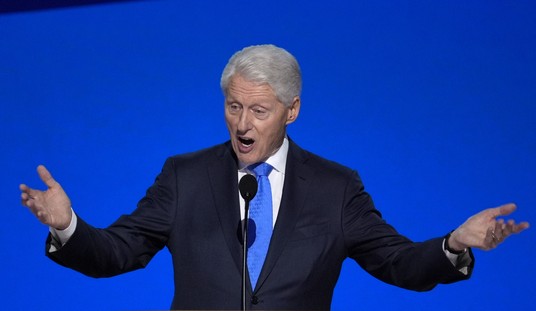We’re hearing a lot of nostalgia for the Clinton era in this debate over the upcoming fiscal cliff. Democrats argue that we need to return to the Clinton-era tax rates in order to get back to Clinton-era budget stability, but that argument utterly founders on the facts — and I’m not the only one to notice that. Michael Barone points out a few inconvenient truths in today’s New York Post about revenues and tax rates from the Clinton era to show that the current fiscal crisis comes from the other side of the ledger:
Over that period of nearly three-quarters of a century, federal receipts have never exceeded 20.9 percent of gross domestic product. That was the number for the war year 1944.
The highest number since was the 20.6 percent of GDP in 2000, the climax of the dotcom boom. In the Obama years, federal receipts have hovered at 15 percent of GDP.
That’s just because tax rates are too low, Obama backers reply. Just raise the rates on high earners, and the problem will be solved.
Actually, high earners don’t make enough money to close the current budget deficit. You’d need to raise taxes on middle-income earners too.
But we have had higher income tax rates in most of the years since World War II. What history and Table B-79 show is that even much higher rates — like the 91 percent marginal rate on top earners imposed from the 1940s to the 1960s — have never produced federal receipts higher than 20 percent of GDP.
Why is that? As the late Jack Kemp liked to say, when you tax something, you get less of it. When the government took 91 percent of what the law defined as adjusted gross income over a certain amount, not many people had adjusted gross income over that amount.
Let’s say, though, that a return to Clinton-era tax rates would produce 20.6% of GDP in federal revenue. We’d still have massive deficits, because we’re spending twenty-five percent of GDP at the federal level. In order to return to the Clinton era, I argue in my column for The Fiscal Times, we’d have to undo the spending spree that took place in both the Bush and Obama presidencies:
In his eight years as President, Clinton reduced federal spending to 18.2 percent of GDP from 22.1 percent, thanks in large part to a Republican-controlled Congress that forced the issue. Defense spending as a portion of GDP declined by 1.8 points, but non-defense spending dropped by 2.2 points. Clinton and the Republicans in Congress cut spending on domestic discretionary programs as well as entitlement spending through welfare reform.
What followed afterward is instructive to the real problem of our current trillion-dollar trajectory of deficit spending. George Bush increased federal spending as a share of GDP by 2.6 points in two terms, and it wasn’t just spent on defense; the increase was split evenly between defense and non-defense spending, a remarkable statistic considering the two wars waged in those eight years.
Barack Obama managed to hike it 3.5 points in just one term, with 3.2 points going to non-defense spending. Under Obama, federal spending now exceeds 25 percent of GDP, and his has been the biggest increase of any of his predecessors over the last 60 years – even for two-term Presidents.
The real debate over deficits isn’t over whether to go back to Clinton-era tax rates. It’s how to get back to Clinton-era spending levels, and then create a tax system that will adequately fund it. The 18.2 percent level of federal spending is one piece of Clinton-era nostalgia worth recalling – as well as the bipartisanship that eventually produced it.
The column should have included a link to the analysis provided by Cato’s Steve Hanke in his fact-check of the roundtable on Meet the Press this week. Professor Hanke (Johns Hopkins University) developed this table from OMB source data, which clearly shows how, when, and where we dug ourselves into this debt and deficit trap. Here’s a hint — it didn’t come from defense spending on wars:
George Will lays out what Clinton-era policies would look like today had they been continued, or reimposed:
Democrats insist that the manufactured unpleasantness due Jan. 1 is a crisis of insufficient revenue. But Jeffrey Dorfman, a University of Georgia economics professor, thinks arithmetic says otherwise. Writing for RealClearMarkets, he says that possible tax increases and spending cuts would reduce the current deficit by less than a third, leaving a deficit larger than any run by any president not named Obama.
At the end of the Clinton administration, when the budget was balanced (largely by revenue generated by commercialization of the Internet), annual federal spending was $1.94 trillion and revenue was $2.10 trillion. “Adjusting for inflation and population growth since the start of 2001,” Dorfman writes, “today’s equivalents would be $2.77 trillion and $3.00 trillion,” and a $230 billion surplus.
What is to blame for today’s huge imbalance? The George W. Bush tax cuts? The recession? Obama’s spending? Dorfman answers yes, yes and yes — but that “spending is the main culprit” because: Today federal revenue is $2.67 trillion (slightly less than “the Clinton equivalent”) and spending is $3.76 trillion, so we are spending $987 billion more than we would be if we had just increased Bill Clinton’s last budget for inflation and population growth.
We cannot continue to spend at this rate, not without massively confiscatory tax rates across the broad spectrum of earners. We have to cut spending dramatically in order to even get close to balance, and reverse the free-spending trend of the last twelve years. Nothing else will work, and massive confiscation will end up crashing the economy and making the deficit situation even worse.
If we go back to Clinton-era tax rates, we have to go back to Clinton-era spending rates too in order to solve the problem. That means entitlement reform and serious cuts in spending now as well as in the long term. Everything else is simply hobby-horse riding.
Will anyone get serious about addressing the real cause of the crisis? David Harsanyi hasn’t seen any reason for optimism from either side yet:
The “fiscal cliff” deal House Republicans and President Barack Obama are debatingcan be called many things — the “avoiding a political nightmare” deal or a “Yes, Mr. Obama, may I have another” deal — but please let’s stop referring to it as a “deficit reduction” deal. We’ve yet to see a serious proposal on debt.
Actually, by proposing a tax increase for spending with no real corresponding cuts, the president has been arguing for growing deficits. And with a priority on “fairness” over prosperity, any chance of easing the $16 trillion national debt through an economic boom in the near future is improbable. …
But all of Obama’s pro-debt expansion policies don’t excuse Republicans for calling their own proposala “credible” $2.2 trillion plan on “deficit reduction.” Even if we were to concede for a moment that the plan would cut the debt, by the time we realized $2.2 trillion in savings, the Congressional Budget Office projects that debt as a share of GDP will have reached 100 percent. By 2035, we’re looking at 200 percent.
Or put it this way: The entire Republican plan would only pay down the $220 billion in net interest the United States owes on its debt every year. Well, if by some miracle that interest stayed at $220 billion. Which it won’t.
The Republicans’ offer also contains $800 billion in new “revenue” garnered from tax reform — partially from closing loopholes on the wealthy — which surrenders to the notion that “revenue” rather than “spending” drives the deficit.
I’d trade some revenue for a serious effort to solve the actual drivers of the crisis. So far, I haven’t seen one yet, either — with the exception of Simpson-Bowles, which for all its flaws actually gets the US moving in the right direction, and the Paul Ryan plan, which has no chance of even getting another hearing in the Senate. Republicans should present Simpson-Bowles in toto and dare Democrats to vote against it.









Join the conversation as a VIP Member